语言学复习资料
- 格式:doc
- 大小:170.50 KB
- 文档页数:21
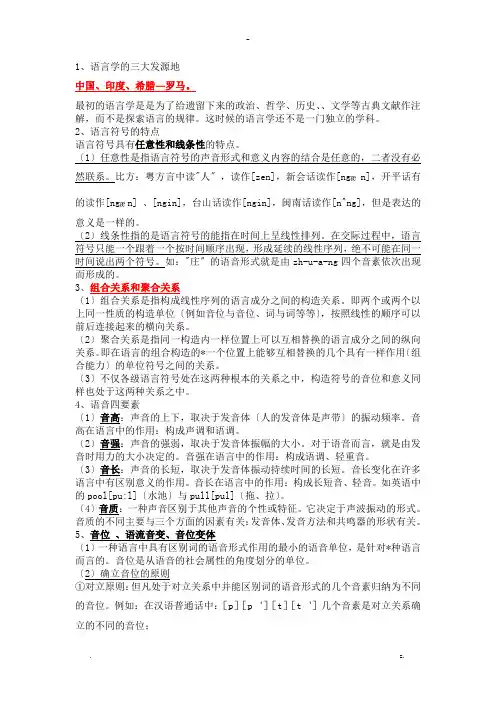
1、语言学的三大发源地中国、印度、希腊—罗马。
最初的语言学是是为了给遗留下来的政治、哲学、历史、、文学等古典文献作注解,而不是探索语言的规律。
这时候的语言学还不是一门独立的学科。
2、语言符号的特点语言符号具有任意性和线条性的特点。
〔1〕任意性是指语言符号的声音形式和意义内容的结合是任意的,二者没有必然联系。
比方:粤方言中读"人〞,读作[zen],新会话读作[ngæ n],开平话有的读作[ngæn] 、[ngin],台山话读作[ngin],闽南话读作[n^ng],但是表达的意义是一样的。
〔2〕线条性指的是语言符号的能指在时间上呈线性排列。
在交际过程中,语言符号只能一个跟着一个按时间顺序出现,形成延续的线性序列,绝不可能在同一时间说出两个符号。
如:"庄〞的语音形式就是由zh-u-a-ng四个音素依次出现而形成的。
3、组合关系和聚合关系〔1〕组合关系是指构成线性序列的语言成分之间的构造关系。
即两个或两个以上同一性质的构造单位〔例如音位与音位、词与词等等〕,按照线性的顺序可以前后连接起来的横向关系。
〔2〕聚合关系是指同一构造内一样位置上可以互相替换的语言成分之间的纵向关系。
即在语言的组合构造的*一个位置上能够互相替换的几个具有一样作用〔组合能力〕的单位符号之间的关系。
〔3〕不仅各级语言符号处在这两种根本的关系之中,构造符号的音位和意义同样也处于这两种关系之中。
4、语音四要素〔1〕音高:声音的上下,取决于发音体〔人的发音体是声带〕的振动频率。
音高在语言中的作用:构成声调和语调。
〔2〕音强:声音的强弱,取决于发音体振幅的大小。
对于语音而言,就是由发音时用力的大小决定的。
音强在语言中的作用:构成语调、轻重音。
〔3〕音长:声音的长短,取决于发音体振动持续时间的长短。
音长变化在许多语言中有区别意义的作用。
音长在语言中的作用:构成长短音、轻音。
如英语中的pool[pu:l]〔水池〕与pull[pul]〔拖、拉〕。
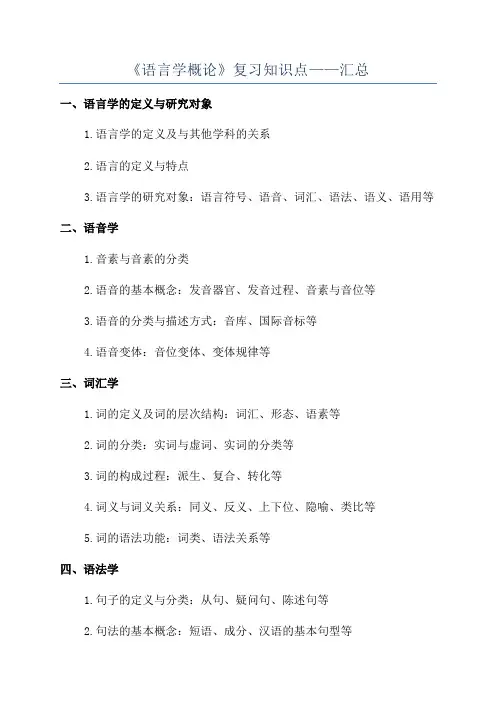
《语言学概论》复习知识点——汇总一、语言学的定义与研究对象1.语言学的定义及与其他学科的关系2.语言的定义与特点3.语言学的研究对象:语言符号、语音、词汇、语法、语义、语用等二、语音学1.音素与音素的分类2.语音的基本概念:发音器官、发音过程、音素与音位等3.语音的分类与描述方式:音库、国际音标等4.语音变体:音位变体、变体规律等三、词汇学1.词的定义及词的层次结构:词汇、形态、语素等2.词的分类:实词与虚词、实词的分类等3.词的构成过程:派生、复合、转化等4.词义与词义关系:同义、反义、上下位、隐喻、类比等5.词的语法功能:词类、语法关系等四、语法学1.句子的定义与分类:从句、疑问句、陈述句等2.句法的基本概念:短语、成分、汉语的基本句型等3.句法关系与句法结构:并列、从属、修饰等4.句法规则与句法分析:形式语法、语义角度的句法分析等5.语法现象的分析与解释:形式语法与功能语法的对比、语法规则、语法的普遍性、语法的可及性等五、语义学1.语义的定义与特点2.词义的构成与分类:词汇意义、语法意义、逻辑意义、上下文意义等3.语义关系与语义角色:同义、反义、上下位、隐喻、类比、关联等4.语义现象的分析与解释:语义成分的划分与关系、语义的可及性、语义的派生与转化等六、语用学1.语用学的定义与研究领域2.语言交际与语言交际行为:意图、目的、合作原则等3.言外之意与言外之行:言外之意的表示方式、言外之行的示例等4.语用现象的分析与解释:语言行为、语用规则、语用的多样性等七、语言学研究方法与分支学科1.语言学研究的方法论:描述性研究、实证研究等2.语言学的分支学科:应用语言学、对比语言学、历史语言学、社会语言学等3.参考书目和领域动态:《现代语言学导论》、《实用语义学》、《语法学》等这些都是《语言学概论》中的重要知识点,希望以上内容对您的复习有所帮助。
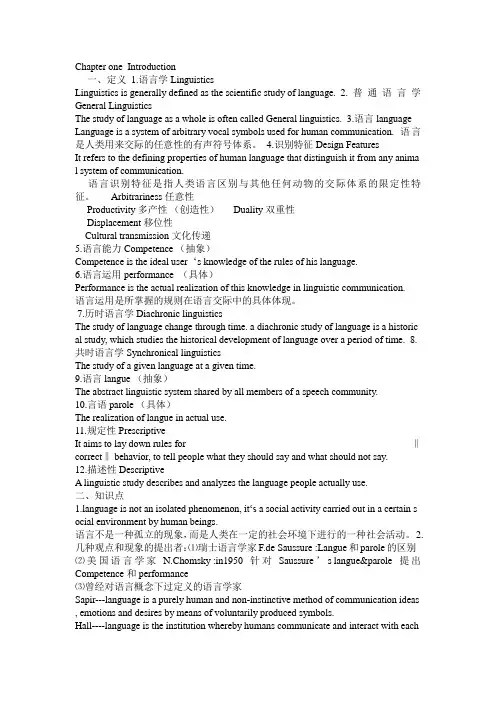
Chapter one Introduction一、定义 1.语言学LinguisticsLinguistics is generally defined as the scientific study of language. 2.普通语言学General LinguisticsThe study of language as a whole is often called General linguistics. 3.语言language Language is a system of arbitrary vocal symbols used for human communication. 语言是人类用来交际的任意性的有声符号体系。
4.识别特征Design FeaturesIt refers to the defining properties of human language that distinguish it from any anima l system of communication.语言识别特征是指人类语言区别与其他任何动物的交际体系的限定性特征。
Arbitrariness任意性Productivity多产性(创造性) Duality双重性Displacement移位性Cultural transmission文化传递5.语言能力Competence (抽象)Competence is the ideal user‘s knowledge of the rules of his language.6.语言运用performance (具体)Performance is the actual realization of this knowledge in linguistic communication. 语言运用是所掌握的规则在语言交际中的具体体现。
7.历时语言学Diachronic linguisticsThe study of language change through time. a diachronic study of language is a historic al study, which studies the historical development of language over a period of time. 8.共时语言学Synchronical linguisticsThe study of a given language at a given time.9.语言langue (抽象)The abstract linguistic system shared by all members of a speech community.10.言语parole (具体)The realization of langue in actual use.11.规定性PrescriptiveIt aims to lay down rules for ‖correct‖ behavior, to tell people what they should say and what should not say.12.描述性DescriptiveA linguistic study describes and analyzes the language people actually use.二、知识点nguage is not an isolated phenomenon, it‘s a social activity carried out in a certain s ocial environment by human beings.语言不是一种孤立的现象,而是人类在一定的社会环境下进行的一种社会活动。
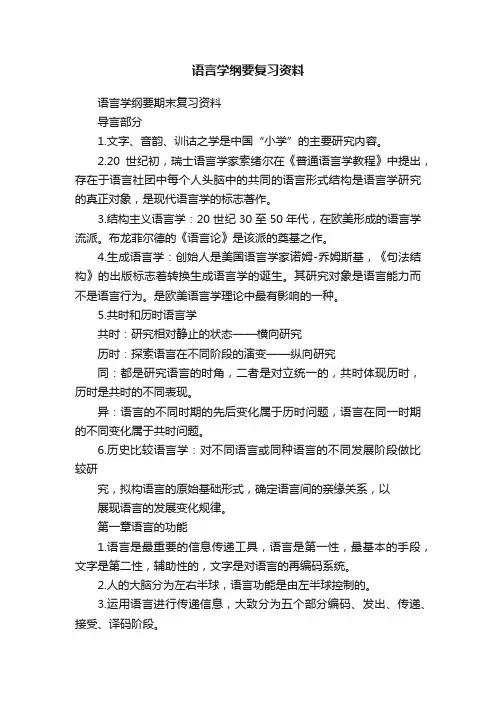
语言学纲要复习资料语言学纲要期末复习资料导言部分1.文字、音韵、训诂之学是中国“小学”的主要研究内容。
2.20世纪初,瑞士语言学家索绪尔在《普通语言学教程》中提出,存在于语言社团中每个人头脑中的共同的语言形式结构是语言学研究的真正对象,是现代语言学的标志著作。
3.结构主义语言学:20世纪30至50年代,在欧美形成的语言学流派。
布龙菲尔德的《语言论》是该派的奠基之作。
4.生成语言学:创始人是美国语言学家诺姆-乔姆斯基,《句法结构》的出版标志着转换生成语言学的诞生。
其研究对象是语言能力而不是语言行为。
是欧美语言学理论中最有影响的一种。
5.共时和历时语言学共时:研究相对静止的状态——横向研究历时:探索语言在不同阶段的演变——纵向研究同:都是研究语言的时角,二者是对立统一的,共时体现历时,历时是共时的不同表现。
异:语言的不同时期的先后变化属于历时问题,语言在同一时期的不同变化属于共时问题。
6.历史比较语言学:对不同语言或同种语言的不同发展阶段做比较研究,拟构语言的原始基础形式,确定语言间的亲缘关系,以展现语言的发展变化规律。
第一章语言的功能1.语言是最重要的信息传递工具,语言是第一性,最基本的手段,文字是第二性,辅助性的,文字是对语言的再编码系统。
2.人的大脑分为左右半球,语言功能是由左半球控制的。
3.运用语言进行传递信息,大致分为五个部分编码、发出、传递、接受、译码阶段。
4.思维方式的差异更多地体现在不同语言在表达思想时语法方面的特点。
5.思维能力的普遍性和思维方式的特殊性,与语言的性质是密切相关的。
6.语言和言语的区分是索绪尔提出的,言语不稳定,语言是稳定的。
7.语言是符号系统,是最重要最典型的符号,符号的形式和意义是约定,无必然联系。
征候是事物本身的特征,它传递的某种信息,可以通过它自身的物质属性来推断。
(远处的炊烟、病人的脉象、气色、舌苔、口气,罪犯的指纹,脚印)8.音————义————心理现实————客观现实语言符号指称反映客观现实:是四维时空中外在于人的所有存在,当下和历史上所有的人物、事物、现象以及他们的相互关系及其变化。
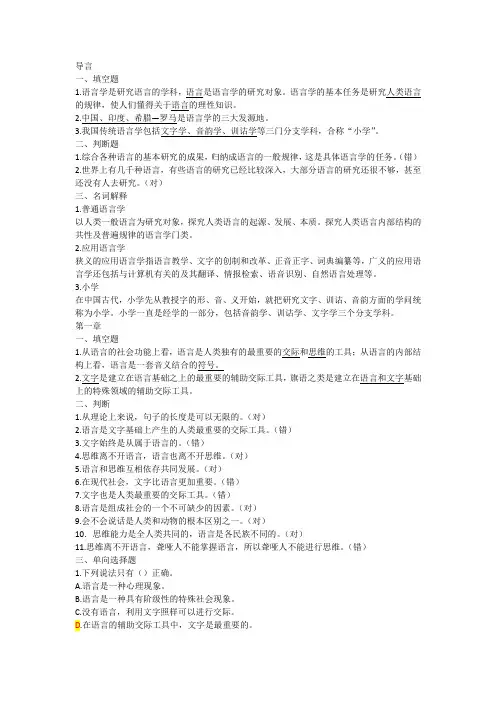
导言一、填空题1.语言学是研究语言的学科,语言是语言学的研究对象。
语言学的基本任务是研究人类语言的规律,使人们懂得关于语言的理性知识。
2.中国、印度、希腊—罗马是语言学的三大发源地。
3.我国传统语言学包括文字学、音韵学、训诂学等三门分支学科,合称“小学”。
二、判断题1.综合各种语言的基本研究的成果,归纳成语言的一般规律,这是具体语言学的任务。
(错)2.世界上有几千种语言,有些语言的研究已经比较深入,大部分语言的研究还很不够,甚至还没有人去研究。
(对)三、名词解释1.普通语言学以人类一般语言为研究对象,探究人类语言的起源、发展、本质。
探究人类语言内部结构的共性及普遍规律的语言学门类。
2.应用语言学狭义的应用语言学指语言教学、文字的创制和改革、正音正字、词典编纂等,广义的应用语言学还包括与计算机有关的及其翻译、情报检索、语音识别、自然语言处理等。
3.小学在中国古代,小学先从教授字的形、音、义开始,就把研究文字、训诂、音韵方面的学问统称为小学。
小学一直是经学的一部分,包括音韵学、训诂学、文字学三个分支学科。
第一章一、填空题1.从语言的社会功能上看,语言是人类独有的最重要的交际和思维的工具;从语言的内部结构上看,语言是一套音义结合的符号。
2.文字是建立在语言基础之上的最重要的辅助交际工具,旗语之类是建立在语言和文字基础上的特殊领域的辅助交际工具。
二、判断1.从理论上来说,句子的长度是可以无限的。
(对)2.语言是文字基础上产生的人类最重要的交际工具。
(错)3.文字始终是从属于语言的。
(错)4.思维离不开语言,语言也离不开思维。
(对)5.语言和思维互相依存共同发展。
(对)6.在现代社会,文字比语言更加重要。
(错)7.文字也是人类最重要的交际工具。
(错)8.语言是组成社会的一个不可缺少的因素。
(对)9.会不会说话是人类和动物的根本区别之一。
(对)10.思维能力是全人类共同的,语言是各民族不同的。
(对)11.思维离不开语言,聋哑人不能掌握语言,所以聋哑人不能进行思维。
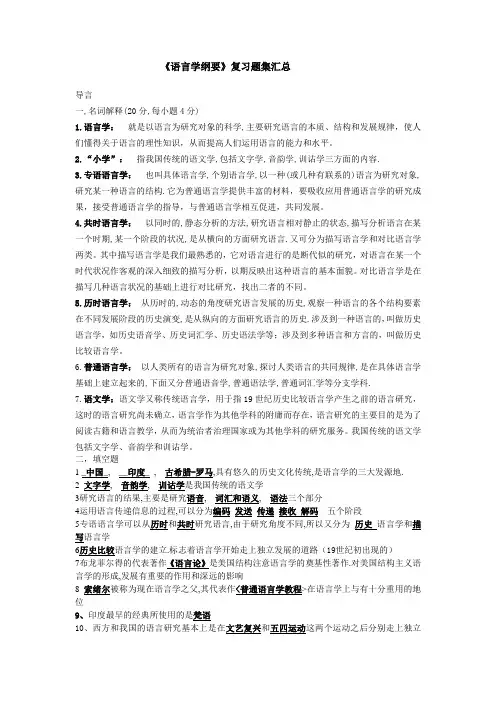
《语言学纲要》复习题集汇总导言一,名词解释(20分,每小题4分)1.语言学:就是以语言为研究对象的科学,主要研究语言的本质、结构和发展规律,使人们懂得关于语言的理性知识,从而提高人们运用语言的能力和水平。
2.“小学”:指我国传统的语文学,包括文字学,音韵学,训诂学三方面的内容.3.专语语言学:也叫具体语言学,个别语言学,以一种(或几种有联系的)语言为研究对象,研究某一种语言的结构.它为普通语言学提供丰富的材料,要吸收应用普通语言学的研究成果,接受普通语言学的指导,与普通语言学相互促进,共同发展。
4.共时语言学:以同时的,静态分析的方法,研究语言相对静止的状态,描写分析语言在某一个时期,某一个阶段的状况,是从横向的方面研究语言.又可分为描写语言学和对比语言学两类。
其中描写语言学是我们最熟悉的,它对语言进行的是断代似的研究,对语言在某一个时代状况作客观的深入细致的描写分析,以期反映出这种语言的基本面貌。
对比语言学是在描写几种语言状况的基础上进行对比研究,找出二者的不同。
5.历时语言学:从历时的,动态的角度研究语言发展的历史,观察一种语言的各个结构要素在不同发展阶段的历史演变,是从纵向的方面研究语言的历史.涉及到一种语言的,叫做历史语言学,如历史语音学、历史词汇学、历史语法学等;涉及到多种语言和方言的,叫做历史比较语言学。
6.普通语言学:以人类所有的语言为研究对象,探讨人类语言的共同规律,是在具体语言学基础上建立起来的,下面又分普通语音学,普通语法学,普通词汇学等分支学科.7.语文学:语文学又称传统语言学,用于指19世纪历史比较语言学产生之前的语言研究,这时的语言研究尚未确立,语言学作为其他学科的附庸而存在,语言研究的主要目的是为了阅读古籍和语言教学,从而为统治者治理国家或为其他学科的研究服务。
我国传统的语文学包括文字学、音韵学和训诂学。
二,填空题1 _中国_, __印度__, 古希腊-罗马,具有悠久的历史文化传统,是语言学的三大发源地.2 文字学, 音韵学,训诂学是我国传统的语文学3研究语言的结果,主要是研究语音, 词汇和语义, 语法三个部分4运用语言传递信息的过程,可以分为编码发送传递接收解码五个阶段5专语语言学可以从历时和共时研究语言,由于研究角度不同,所以又分为历史语言学和描写语言学6历史比较语言学的建立.标志着语言学开始走上独立发展的道路(19世纪初出现的)7布龙菲尔得的代表著作《语言论》是美国结构注意语言学的奠基性著作.对美国结构主义语言学的形成,发展有重要的作用和深远的影响8_索绪尔被称为现在语言学之父,其代表作<普通语言学教程>在语言学上与有十分重用的地位9、印度最早的经典所使用的是梵语10、西方和我国的语言研究基本上是在文艺复兴和五四运动这两个运动之后分别走上独立发展的道路的。

第一章语言和语言学1.语言与各个领域的社会活动都有着密切的联系,在这种情况下,语言学必须明确自己的研究对象,才能成为一门现代意义上的科学。
2.任何符号,包括语言符号都是形式和意义的统一体。
3.什么是语言的客观存在形式语言的客观存在形式首先表示为有声的口头语言即口语,而当出现了文字以后,又表现为有形的书面语言即书面语。
4.语言符号的强制性正因为语言符号是社会约定俗成的,因此在同一社会,同一时代,对使用同一种语言的每一个社会成员来说是强制性的,是不能任意改变的,因为如果个人可以任意改变,那就互相听不懂了,也就从根本上丧失了交际工具的作用。
5.语言与言语的区别语言是言语活动中同一社会群体共同掌握的、有规律可循而又成系统的那一部分;而含有个人要素或个人杂质的说话行为和说出来的话只能属于言语。
第二章语音1.声音的四要素:音高,音强,音长,音质2.振幅:也就是发音体振动时离开平衡位置的最大偏移距离。
3.频率:发音体在每一秒钟内振动的次数。
4.音高:就是声音的高低。
它是由频率的大小决定的。
频率同音高成正比。
频率越大,声音越高;频率越小,声音越低。
5.音强:就是声音的强弱。
它是由振幅的大小决定的。
振幅同音强成正比,振幅的大小又决定于使发音体振动外力的大小。
外力大,振幅就大,声音就强;外力小,振幅就小,声音就弱。
6.音长:就是声音的长短。
它是由发音体振动的持续时间决定的。
发音体振动的持续时间长,声音就长;发音体振动的时间短,声音就短。
7.基音:振动中有一个频率最低的振动,由它发出的声音叫做“基音”。
其他振动发出的声音叫做“陪音”。
8.乐音:当基音的频率的陪音的频率之间存在着整数倍的比例关系时,会形成一种复杂而有规则的,具有周期性重复特征的声波形式,这种声音叫做乐音。
9.噪音:如果基音的频率和陪音的频率之间不存在整倍数的比例关系,就会形成一种杂乱无章的不规则的声波形式,这种声音叫做噪音。
10.语音的生理基础:语音是由人的发音器官协同动作而产生的,人的发音及其运动是“语音的生理基础”,决定着语音的生理特征。
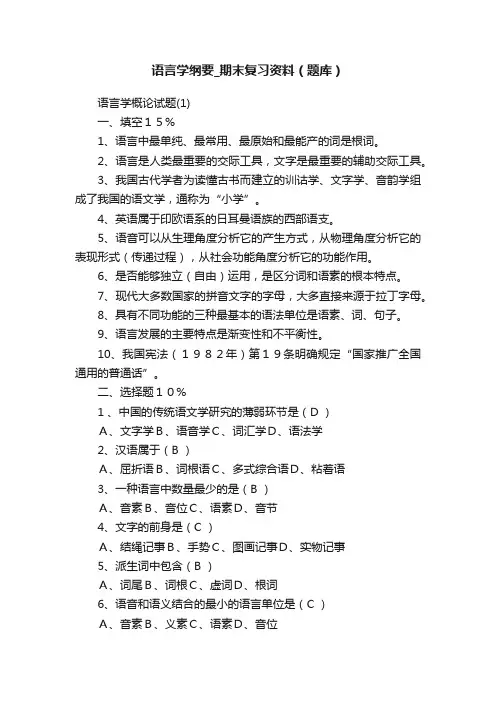
语言学纲要_期末复习资料(题库)语言学概论试题(1)一、填空15%1、语言中最单纯、最常用、最原始和最能产的词是根词。
2、语言是人类最重要的交际工具,文字是最重要的辅助交际工具。
3、我国古代学者为读懂古书而建立的训诂学、文字学、音韵学组成了我国的语文学,通称为“小学”。
4、英语属于印欧语系的日耳曼语族的西部语支。
5、语音可以从生理角度分析它的产生方式,从物理角度分析它的表现形式(传递过程),从社会功能角度分析它的功能作用。
6、是否能够独立(自由)运用,是区分词和语素的根本特点。
7、现代大多数国家的拼音文字的字母,大多直接来源于拉丁字母。
8、具有不同功能的三种最基本的语法单位是语素、词、句子。
9、语言发展的主要特点是渐变性和不平衡性。
10、我国宪法(1982年)第19条明确规定“国家推广全国通用的普通话”。
二、选择题10%1 、中国的传统语文学研究的薄弱环节是(D )A、文字学B、语音学C、词汇学D、语法学2、汉语属于(B )A、屈折语B、词根语C、多式综合语D、粘着语3、一种语言中数量最少的是(B )A、音素B、音位C、语素D、音节4、文字的前身是(C )A、结绳记事B、手势C、图画记事D、实物记事5、派生词中包含(B )A、词尾B、词根C、虚词D、根词6、语音和语义结合的最小的语言单位是(C )A、音素B、义素C、语素D、音位7、汉语单词“忽然”出现的位置是(C )A、主语位置B、谓语位置C、状语位置D、定语位置8、以下各种语言变体中,属于社会方言的是(D )A、土话B、客家话C、客套话D、黑话9、下列语素中属于自由语素的是(C )A、初B、视C、人D、民10、在语言结构的某一环节上能够互相替换,具有某种相同作用的各个单位之间所形成的关系叫(D )A、转换关系B、组合关系C、层级关系D、聚合关系三、名词解释20%1、专语语言学: 以具体语言作为研究对象的语言学。
2、组合关系: 指两个以上相连续的语言符号组合而成的线性关系。
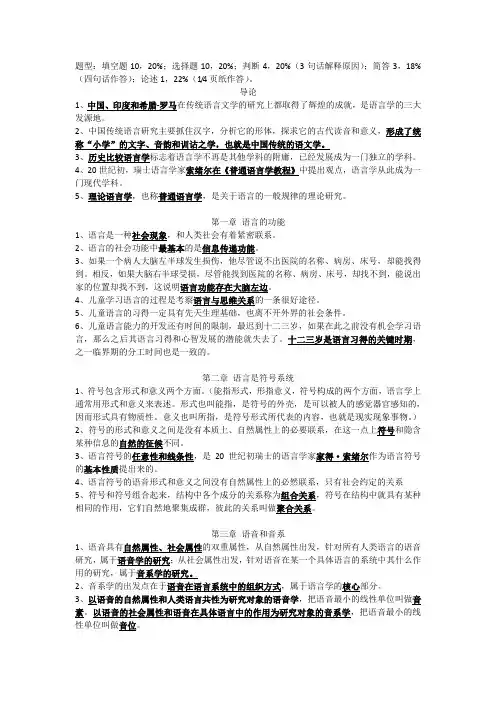
题型:填空题10,20%;选择题10,20%;判断4,20%(3句话解释原因);简答3,18%(四句话作答);论述1,22%(1/4页纸作答)。
导论1、中国、印度和希腊-罗马在传统语言文学的研究上都取得了辉煌的成就,是语言学的三大发源地。
2、中国传统语言研究主要抓住汉字,分析它的形体,探求它的古代读音和意义,形成了统称“小学”的文字、音韵和训诂之学,也就是中国传统的语文学。
3、历史比较语言学标志着语言学不再是其他学科的附庸,已经发展成为一门独立的学科。
4、20世纪初,瑞士语言学家索绪尔在《普通语言学教程》中提出观点,语言学从此成为一门现代学科。
5、理论语言学,也称普通语言学,是关于语言的一般规律的理论研究。
第一章语言的功能1、语言是一种社会现象,和人类社会有着紧密联系。
2、语言的社会功能中最基本的是信息传递功能。
3、如果一个病人大脑左半球发生损伤,他尽管说不出医院的名称、病房、床号,却能找得到。
相反,如果大脑右半球受损,尽管能找到医院的名称、病房、床号,却找不到,能说出家的位置却找不到,这说明语言功能存在大脑左边。
4、儿童学习语言的过程是考察语言与思维关系的一条很好途径。
5、儿童语言的习得一定具有先天生理基础,也离不开外界的社会条件。
6、儿童语言能力的开发还有时间的限制,最迟到十二三岁,如果在此之前没有机会学习语言,那么之后其语言习得和心智发展的潜能就失去了。
十二三岁是语言习得的关键时期,之一临界期的分工时间也是一致的。
第二章语言是符号系统1、符号包含形式和意义两个方面。
(能指形式,形指意义,符号构成的两个方面,语言学上通常用形式和意义来表述。
形式也叫能指,是符号的外壳,是可以被人的感觉器官感知的,因而形式具有物质性。
意义也叫所指,是符号形式所代表的内容,也就是现实现象事物。
)2、符号的形式和意义之间是没有本质上、自然属性上的必要联系,在这一点上符号和隐含某种信息的自然的征候不同。
3、语言符号的任意性和线条性,是20世纪初瑞士的语言学家家得·索绪尔作为语言符号的基本性质提出来的。
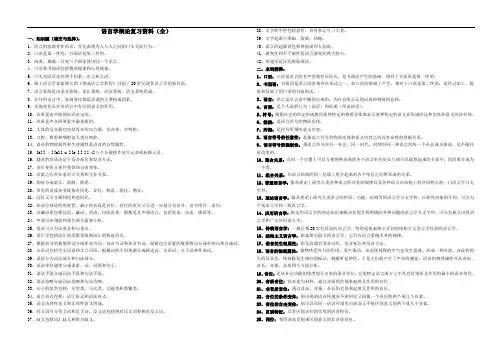
语言学概论复习资料(全)一、知识题(填空与选择):1、语言的客观存在形式,首先表现为人与人之间的口头交际行为。
2、口语是第一性的,书面语是第二性的。
3、瑞典、挪威、丹麦三个国家使用同一个语言。
4、口语和书面语包括物理现象和心理现象。
5、口头交际活动有两个因素:语言和言语。
6、瑞士语言学家索绪尔的《普通语言学教程》开创了20世纪现代语言学的新局面。
7、语言系统是由语音系统、语汇系统、语法系统、语义系统组成。
8、在任何语言中,音调变化都是语调的主要构成因素。
9、音强变化在许多语言中有区别意义的作用。
10、音质是由声波的形式决定的。
11、音质是声音四要素中最重要的。
12、人体的发音器官包括发音的动力源、发音体、共鸣腔。
13、口腔、鼻腔和咽腔是人类共鸣腔。
14、语音的物理属性和生理属性是语音的自然属性。
15、[e][ ε][a][ u ][o ][ ][ ɑ]八个音被称作定位元音或标准元音。
16、辅音的音质决定于发音部位和发音方法。
17、音位变体分条件变体和自由变体。
18、音素之间存在着对立关系和互补关系。
19、韵母分成韵头、韵腹、韵尾。
20、常见的语流音变现象有同化、异化、脱落、弱化、增音。
21、同化又可分顺同化和逆同化。
22、从音位理论的角度看,最小的音段是音位。
音位的组合又可进一步划分为音节、音节组合、语句。
23、汉藏语系包括汉语、藏语、苗语。
印欧语系一般都是非声调语言,包括英语、法语、俄语等。
24、声调可从调值和调位两方面来分析。
25、重音可分为词重音和句重音。
26、语汇学包括语汇的类聚系统和语汇的构造形式。
27、根据音节的数量将词分成单音节词、双音节词和多音节词。
根据包含语素的数量将词分成单纯词和合成词。
28、古语词包括历史词语和文言词语。
根据词的不同来源分成新造词、古语词、方言词和外来词。
29、语法分为词法部分和句法部分。
30、语法单位通常分成语素、词、词组和句子。
31、语法手段分成词法手段和句法手段。
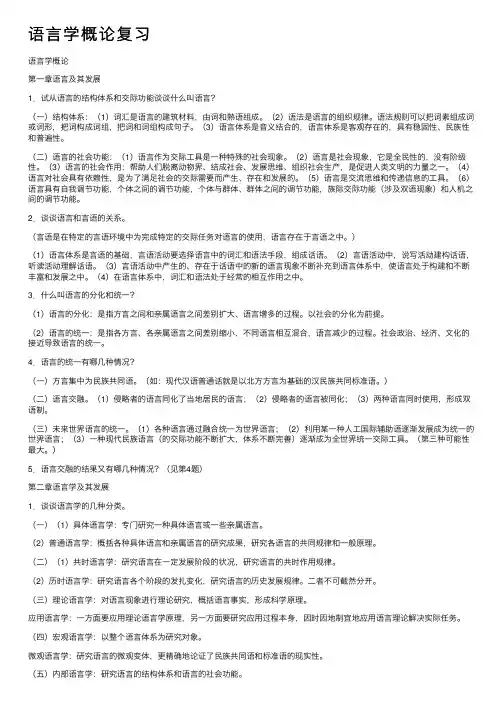
语⾔学概论复习语⾔学概论第⼀章语⾔及其发展1.试从语⾔的结构体系和交际功能谈谈什么叫语⾔?(⼀)结构体系:(1)词汇是语⾔的建筑材料,由词和熟语组成。
(2)语法是语⾔的组织规律。
语法规则可以把词素组成词或词形,把词构成词组,把词和词组构成句⼦。
(3)语⾔体系是⾳义结合的,语⾔体系是客观存在的,具有稳固性、民族性和普遍性。
(⼆)语⾔的社会功能:(1)语⾔作为交际⼯具是⼀种特殊的社会现象。
(2)语⾔是社会现象,它是全民性的,没有阶级性。
(3)语⾔的社会作⽤:帮助⼈们脱离动物界、结成社会、发展思维、组织社会⽣产,是促进⼈类⽂明的⼒量之⼀。
(4)语⾔对社会具有依赖性,是为了满⾜社会的交际需要⽽产⽣、存在和发展的。
(5)语⾔是交流思维和传递信息的⼯具。
(6)语⾔具有⾃我调节功能,个体之间的调节功能,个体与群体、群体之间的调节功能,族际交际功能(涉及双语现象)和⼈机之间的调节功能。
2.谈谈语⾔和⾔语的关系。
(⾔语是在特定的⾔语环境中为完成特定的交际任务对语⾔的使⽤,语⾔存在于⾔语之中。
)(1)语⾔体系是⾔语的基础,⾔语活动要选择语⾔中的词汇和语法⼿段,组成话语。
(2)⾔语活动中,说写活动建构话语,听读活动理解话语。
(3)⾔语活动中产⽣的、存在于话语中的新的语⾔现象不断补充到语⾔体系中,使语⾔处于构建和不断丰富和发展之中。
(4)在语⾔体系中,词汇和语法处于经常的相互作⽤之中。
3.什么叫语⾔的分化和统⼀?(1)语⾔的分化:是指⽅⾔之间和亲属语⾔之间差别扩⼤、语⾔增多的过程。
以社会的分化为前提。
(2)语⾔的统⼀:是指各⽅⾔、各亲属语⾔之间差别缩⼩,不同语⾔相互混合,语⾔减少的过程。
社会政治、经济、⽂化的接近导致语⾔的统⼀。
4.语⾔的统⼀有哪⼏种情况?(⼀)⽅⾔集中为民族共同语。
(如:现代汉语普通话就是以北⽅⽅⾔为基础的汉民族共同标准语。
)(⼆)语⾔交融。
(1)侵略者的语⾔同化了当地居民的语⾔;(2)侵略者的语⾔被同化;(3)两种语⾔同时使⽤,形成双语制。
语言学概要复习提纲一、导言一、语言学的对象和任务(一)语言学的对象和任务1.定义:语言学是研究语言现象和规律的科学。
2.研究对象:语言。
语言学概论的研究对象:整个人类的语言。
3.主要任务:研究语言的性质、作用、结构和规律,使对语言的认识上升到理性阶段。
4.语言的基本理解语言的性质:是人类最重要的交际工具和思维工具。
语言的结构:是音义结合的符号系统。
语言的要素:语音、语义和词汇、语法。
(二)语言学简史(语文学与语言学)1.语文学阶段(1)三大发源地:①印度②希腊-罗马③中国(2)语文学的作用语文学三大发源地的语言研究各有侧重,共同特点是都注重实用性,与当时社会的需求紧密关联,都形成了丰硕的研究成果,为语言学的诞生奠定了坚实的基础。
(3)语文学与语言学的区别①研究对象不同②研究任务不同因此,语言学是一门独立的学科,语文学只是经学的附庸。
2.语言学阶段(1)历史比较语言学产生时间:19世纪初社会背景:资产阶级革命的成功特点:用历史比较法研究语言奠基人:拉斯克、葆朴、格林等。
历史地位:摆脱了过去从属经学的附庸地位,标志着语言学走上独立发展的道路。
(2)结构主义语言学基础:历史比较语言学时间:19世纪中叶奠基人:德国的洪堡特和瑞士的索绪尔索绪尔被尊称为“现代语言学之父”,他死后由其学生编辑出版的《普通语言学教程》具有划时代的作用。
索绪尔提出的主要理论是:①区分“语言”、“言语”和“言语活动”。
②明确了语言学的研究对象:“语言学的唯一的、真正的对象就是语言和为语言而研究语言。
③论证了语言的符号性:语言符号是由“能指”和“所指”所构成的。
④提出了组合关系和聚合关系。
(3)转换生成(形式)语言学创始人:乔姆斯基(《句法结构》)主要观点:认为语言描写和分析的目的不在于分类,而在于建立一种理论,在于研究人的语言生成能力,即怎样用有限的成分和规则生成无限的句子。
理论构成:主要包括生成规则和转换规则两部分。
①生成规则包括一套短语结构规则和词汇插入规则。
语言学概论(复习提纲)教学内容:(一)语言的特性:自然语言的独特性、语言的本质、语言的普遍性和多样性(二)详细介绍语言学的分支研究(语音、词汇、语义和语法) (三)语言与其他人类知识:语言与社会、语言和文字等第一讲:语言和语言学一.什么是语言?什么是语言学?(掌握)语言学:研究语言的科学二.说话和写字(理解)1.文字是作为补充有声语言而产生的,最初主要用来把言语传至远处和保留下来2.文字的基本和首要任务是补充言语的交际3.语言是第一性的,文字是第二性的三.语言能力和语言运用(了解)语言能力:what you know when you know a language语言运用:运用语言能力说出来的具体的话语语言学研究的是隐藏在话语(语言运用)背后的语言能力第二讲:语言是符号系统一.语言符号的性质和特点(掌握)★1.什么是符号(symbol)?①符号必须是可以感知的,在信息交换中不代表它自身而代表另一事物②符号与它代表的东西之间的关系是约定的2.语言符号:是声音和意义的结合体,声音是语言符号的形式(不是文字),声音和意义之间的关系是约定的3.语言符号特性:①任意性(arbitrariness):最小的语言符号的音与义的结合是任意的,由社会约定俗成②线条性(linearity):语言符号只能一个跟着一个依次出现,在时间线条上绵延,不能在空间上铺开,必须实现为一个单线性的次序才能表达信息。
二.语言符号的系统性(掌握)★1.语言系统是一个分层装置,依靠组合和替换(聚合)来运转。
语言是一个两层多级的系统,每一层都包含不同的级别两层结构形式层(语音)符号层(音义结合的符号、符号的序列)2.组合关系:在线性语流中,语言单位按顺序排列组织成更大一级的单位聚合关系:具有相同特点的同一级的单位形成一个类,这些单位之间的关系叫聚合关系3.语言系统的分支结构三.人类语言的特性(掌握)★四.动物语言(了解)第三讲:语音学一.语音和语音研究(理解)1.广义语音学:phonetics +phonology2.狭义语音学(phonetics)研究人类发音特点,特别是语音发音特点,提出各种语音描写、分类和转写方法的科学二.声波(理解)1.声音是指可听声波的特殊情形2.语音四要素★①音高:声音的高低,由频率决定②音重:声音的轻重或强弱,由振幅决定③音长:声音的长短,由振动的时间决定④音质(音色)发音体不同发音方法不同共鸣器不同3.发音要素三.音素和音标(掌握)★1.音节:在听觉上最容易分辨的音段2.音素:从音质角度划分出来的最小语音单位3.国际音标:①辅音②元音4.辅音:发辅音时气流受到阻碍①发音部位(Place of Articulation):形成阻碍的部位②发音方法(Manner of Articulation):气流受阻碍的方式5.元音:发元音时气流不受到阻碍①舌身的活动(舌位)②是否圆唇③紧松四.汉语的辅音和元音(掌握辅音表和元音图)★五.超音段特征(掌握)★第四讲:音系学一.什么是音系学(phonology)?(理解)1.一个具体语言的语音系统2.哪些语音可以分辨词义?3.哪些语音是可预测的?哪些不可预测?4.在什么语音环境下我们可以预测某些语音?二.音位和音位变体(掌握)★1.音位(phoneme):在具体语言中有区别词义作用的最小语音单位2.音位变体(allophone):在实际语流中实际呈现出来,属于同一音位的各种表层音段三.音位归纳(掌握)★1.最小对立对(minima pair):一对意义不同的词,只有一处音不同,其他语音都相同2.分布(distribution):某“音”出现的一组语音环境①对立分布:在相同的语音环境中,两个音能区别意义②互补分布:两个音不能在相同的语音环境中出现③自由变体:在相同的语音环境中,可以有多种读音3.音位归纳原则①对立的两个音必属两个不同的音位②互补的音可以归纳为一个音位③自由变体的音属同一个音位4.音位变体①条件变体:由语音环境制约的音位变体②自由变体:不同变体可以在同样的环境里无条件地变读四.音系学练习(理解)1.有没有最小对立对?2.列出每个音的出现环境(前面和后面的音)3.找出环境的自然类4.找出互补的环境5.概括每个音的出现条件6.归纳音位和音位变体(决定哪个音位变体是基本的、哪个是受限制的)五.超音段特征(掌握)★在具体语言中,具有区分词义作用的音高、音长、音重六.音位的组合和聚合(掌握)1.发音特征①区别特征:有区别音位作用的发音特征②羡余特征:被其他特征决定的发音特征,必须和其他特征共现,不具有区分音位的作用③变体特征:不具有区分音位的作用,只是音位变体具有的特征2.自然类:具有一个共同的发音特征的不同音位3.平行对称的音位聚合系统①便于记忆②聚合的成员具有相似的构成音节或者构词能力4.音节:在听觉上最容易分辨的音段①一个音节最多能有多少个组合位置?②在每个组合位置上可出现哪些聚合类?③可以出现在各个组合位置上的聚合类有没有共现的限制?5.语流音变:★语音相连时,由于受邻音的影响,或者由于说话时快慢、高低、强弱的不同,可能发生不同的变化①同化②异化③弱化④脱落⑤合音第五讲:形态学(词汇与语义)一.什么是词?(理解)1.词:具体语言中,在造句时可以自由运用的最小单位①独立运用(单说,自由与别的成分组合)②词的意义有约定性和可解释性2.语素是构词的单位,是具体语言中音义结合的最小单位①不成词语素:只能和别的语素结合成词②成词语素:本身能成为一个词, 同时也能和别的语素结合成别的词二.词和形态学(理解)1.派生和屈折2.词缀(affix):附加在另一个语素的各类构形成分①前缀(prefix):添加在词根前的词缀②后缀(suffix):添加在词根后的词缀3.词根(stem)三.语素的分类(理解)四.词的结构(掌握)★1.附加(affixation):词根+词缀2.复合(compounding):词根+词根3.重叠(reduplication)4.交替(alternation):语素内部变换5.异干交替(suppletion):用不相同的形式来填补一个词形变化表6.汉语的构词法①单纯词并列式, 偏正式复合法(词根+词根)陈述式, 支配式②合成词补充式,附加法(词根+词缀)重叠法③简称: 减缩, 紧缩, 概括五.语言的形态类型(掌握)1.分析语黏着语2.综合语屈折语多式综合语第六讲:句法学(语法学)句法研究的三方面1.句法单位、成分组构2.句法功能3.词序一.语法单位(掌握)★1.静态单位(数量有限):语素(morpheme)词(word)2.动态单位(临时的,数量无限):词组(phrase)句子(sentence)二.线性次序,层级结构和歧义(理解)1.线性次序2.层级结构3.歧义三.词组的结构(理解)四.词类(了解)1.为什么要划分词类?具体语言中,能占据不同语法位置的词是有限制的划分词类是为了更有效更方便地说明语法规则2.划分词类的依据①充当句法成分的能力(占据什么语法位置)②和别的成分的组合能力③意义④形态变化五.形态与语法范畴(掌握)★1.表达语法功能(语法关系)的手段选词词序虚词形态变化(词形变化)2.语法范畴:由词形变化表现出来的意义的聚合数时名词性动词体格态六.词组结构规则(了解)语言中片语合成句子的规则七.英语的词组结构规则(了解)八.词序类型学(掌握)VSO语言:19%SVO语言:35%VOS语言:2%SOV语言:44%第七讲:语义学一.语义学和语义研究(掌握)1.语义学(Semantics):研究语言的意义①词义②词义如何组构句义2.什么是语义?3.语义研究二.关于意义的理论(了解)1.词典释义2.心理形象(mental image)3.语义和指称(reference)4.真值条件(truth condition)5.语言使用三.传统语义研究(掌握)传统语义学(19C初):研究词义与语音、客观事物的关系,研究词义的色彩,词义的演变1.词义是词的内容, 是对客观事物现象的反映2.词的感情色彩3.词的语体色彩4.义项5.同义词;反义词;上、下位词★四.语义场和义素分析(掌握)(×)1.语义场意义相近的词W1、W2、W3……构成一个集合,称为词汇场(lexical field)/语义场(semantic field)不同的词汇场F1、F2、F3……的并集构成该语言的词汇的总和V基本观点①语言中的词在一个共同概念的支配下可以构成一个语义场②属于同一个语义场的词在意义上相互联系、相互制约、相互依存2.义素分析(语义成分分析)语言中所有实义词的意义都可以分成各种成分词的意义分解后得到的是语义特征/语义成分(semantic component)/义素(sememe)/语义原子(semantic atom)第八讲:语用学(×)一.什么是语用学?(了解)二.言语行为(理解)三.言情达意:衍推和隐涵(理解)四.会话规则(理解)五.话语分析(理解、掌握)第九讲:心理语言学(×)一.心理语言学(了解)二.语言和大脑(了解)三.语言习得的理论(了解)第十讲:语言的接触一.语言成分的借用和吸收1.借词★2.语法规则的借用二.语言的融合()三.语言接触的三种特殊表现形式()★第十一讲:语言的发展和演变思考题:1.语言符号具有任意性,是约定俗成的。
《语言学纲要》部分复习资料语言学纲要一、名词解释1. 描写语言学:研究某一种或某几种语言一个时间段内的结构规律和这个时间内发生的变化,叫描写语言学2. 普通语言学:以世界各种语言为研究对象,总结其结构规律和发展变化的学科,与个别语言学相对3. 言语:就是对某种具体语言的应用4. 语音学:就是以语音为研究对象,研究语言的发音机制,语音特性和在言谈中的变化规律的学科5. 音位:音位是一种语言或方言中,能区别意义的最小语音单位,也是按语音的辩义作用归纳出来的音类6. 历史比较语言学:用历史的观点,比较的方法,进行语言研究,对语言进行谱系分类7. 摩声说:是有关语言起源的一种说法,认为语言起源于对事物声音的模仿8. 语音:人体发音器官发出来的代表一定意义的声音9. 语义:同语言形式结合在一起的意义,同语言形式的结合是语义的基本特征/(语音形式所负载的意义)10.语言的谱系分类:根据语言的亲属关系对语言所作的分类11.分布:是指语言要素所能出现的和不能出现的环境的总和12.语法:是词、短语、句子等语言单位的结构规律13.文字:是记录语言的书写符号系统,是最重要的辅助性交际工具二、举例说明1.语序、虚词、形态、语调对句法结构的作用1)语序对句法结构的作用:a.我揍你——“我”是施事,“你”是受事b.你揍我——“我”事受事,“你”是施事2)虚词对句法结构的作用:a.我和哥哥——并列关系b.我的哥哥——所属关系3)形态对句法结构的作用:a.miss you——述宾结构b.you miss——主谓结构4)语调对句法结构的作用:a.想起来——重音在“起来”上,是述宾结构b.想起来——重音在“想”上,是补充结构2. 语言借用的三种情况1)语音的借用:侗族语里原本没有/f/这个音,是后来从汉语普通话里借来使用的2)词汇的借用:词汇的借用有借入,借出和借入又借出三种借入的词汇有:苜蓿,镭射,喀秋莎等。
借出的词汇有:china,tea等。
语言学概论复习重点整理语言学是研究语言的科学,是人类学科中的重要分支之一。
它探讨语言的构成、发展、使用、习得等方面的问题。
在语言学的学习中,有几个重点需要重点关注和复习,包括语言的定义与特点、语音学、语法学、语义学、语用学等。
一、语言的定义与特点语言可以定义为人类交流思想和感情的工具,它具有符号性、产生性、传递性和交际性等特点。
符号性是指语言以音、形、色、势等形式来表达,具有特定的语音、文字等符号。
产生性是指语言是人类天生具备的能力,可以随意创造和组合新的语言表达。
传递性是指语言是为了交流而产生的,可以传递信息和意义。
交际性是指语言是社会交往的工具,是人类社会生活的基础。
二、语音学语音学研究语音的产生、组织、传播和知觉等问题。
语音由音段和音素组成,音段是语言中的基本音单位,而音素则是语音学上对音段的理论抽象。
语音学重点研究了语音的发音和声音的特征,包括元音、辅音、音节结构、音位等内容。
三、语法学语法学研究语言的结构和规则,包括句子的构成、词汇的分类和句子的句法规则等。
语法学可以分为句法学、词法学和语法规则等方面的研究。
句法学研究句子的结构和组成,包括词语的层次、短语的组成和句子的句法规则。
词法学研究词汇的构成和分类,包括名词、动词、形容词等的形态学特点和语义学特征。
四、语义学语义学研究语言的意义和语义关系,研究词汇的意义、句子的意义和语义关系的表达方式等。
语义学包括词汇语义学和句子语义学两个方面的内容。
词汇语义学研究词汇的意义和词汇之间的关系,包括语义原理、词汇关系等。
句子语义学研究句子的意义和句子之间的关系,包括句子的逻辑关系、语义角色等。
五、语用学语用学研究语言使用的实际情况,分析语言使用者之间的交际行为和交际行为产生的效果等。
语用学主要研究语言的使用环境、语言行为的目的、语言行为的影响等方面的问题。
例如,研究语言中的礼貌用语、谈话中的暗示和推理、言语行为的意义和效果等。
六、其他相关内容除了以上几个重点内容外,还有一些其他与语言学相关的内容也值得复习和关注。
语言学复习资料Part V: Semantics1. Semantics:the study of meaning, specially the meaning of linguistic units, words and sentences in particular.2. Ogden and Richards (1923): 奥格登和理查兹《意义的意义》The Meaning of Meaning Summary of Important Ones•1)reference•2)concept•3)synonym•4)paraphrase•5)translation equivalent•6)intention•7)implicature3. Leech’s Seven MeaningsLeech— a British modern linguist,《语义学》Semantics (1974) :P-23: Seven Types of Meaning:♠1) Conceptual Meaning 概念意义♠2) Connotative Meaning 内涵意义♠3) Social Meaning 社会意义♠4) Affective Meaning 感情意义♠5) Reflected Meaning 反映意义♠6) Collocative Meaning 搭配意义♠7) Thematic Meaning 主题意义2)-6)属于Associative Meaning联想意义1) Conceptual Meaning 概念意义➢关于逻辑、认知或外延内容的基本意义。
又叫“外延意义”(denotative meaning),也通常是词典给出的定义,概念意义不会因人、因文化而异;可分解成若干“语义成分”。
E.g.•women: [HUMAN] [FEMALE] [ADULT]•Pig: [ANIMALE] [DOMESTICATED]…2)Connotative Meaning 内涵意义➢附加在概念意义之上,通过语言所指事物传递的意义。
语言学概论复习资料一、填空题第一章1.语言学是研究语言的科学。
语言是语言学的研究对象。
语言是人类最重要的交际工具。
语言学的基本任务是研究语言的规律,使人们懂得关于语言的理性知识。
2.中国、印度、希腊-罗马具有悠久的历史文化传统,是语言学的三大发源地。
3.古代读音和意义,形成了统称“小学”的文字、音韵、训诂的我国传统语文学。
4.运用语言进行交际的过程大体上可以分为“编码——发送——传递——接收——解码”五个阶段。
编码和解码是交际过程的两个根本的环节。
5.语言是把人和其他动物区别开来的一个重要的标志。
6.语言是人类最重要的交际工具7.语言是思维的工具8.思维能力是全人类共同的,语言是各民族不同的。
第二章1.语言是符号系统,这句话概括了语言本身的性质和特点。
2.语言符号使用起来最简便,容量最大,效果也最好。
3.音位不是符号,语言中最小的符号是语素,人们自然地感觉到的语言中的单位是词而不是语素。
4.语素是语言中最小的符号,那么词是语言中能够独立使用的符号。
句子是符号和符号组装的成品,是符号的序列,不再是单个的符号。
5.语言符号的最大侍点是它的任意性和线条性6.语言是一种分层装置,这种装置靠组合和替换来运转。
从音位到语素,这是语言分层装置里最关键的接合部. 音位语素→词→句子,这就是语言的层级装置:几十成千→成万→无穷,这就是这个层级装置所提供的效能。
7. 掌握语言需要有发达的大脑和灵活的发音器官,也就是说,要有抽象思维的能力和发音的能力。
第三章1.元音的本质问题:舌位的高低、前后,和嘴唇的圆展。
第六章1.文字是记录语言的书写符号系统第七章1.世界上的各种语言按其亲属关系大致可以分为汉藏语系、印欧语系、乌拉尔语系、阿尔泰语系、闪-含语系、高加索语系、达罗昆荼语系、马来-玻利尼西亚语系、南亚语系以及其他一些语群和语言。
2.在各个语系中,印欧语系是研究得最充分、最深入的一个语系,甚至可以说,“语系”这个概念本身就是在印欧系各种语言的研究基础上提出和发展起来的。
语言学Chapter 7 Language, Culture, and SocietyWhat is culture?广义:the patterns of brief, customs, institutions,techniques,language.侠义:refers to local or specific practice, belief or customs.The relationship Between Language and CultureA.Part to whole (language is a part of culture .)nguage can transport Culture.7.1.1ANTHROPOLOTICAL ATUDY OF LINGUISTICS (人类语言学)定义:study language in a sociocultural context.人物1. Malinowski提出:a.The meaning of a word greatly depended upon its occurrence in a given context.nguage functions as a link in concerted human activity.人物2. Firth: 伦敦学派<London School>的创始人):He developed his own theory of CONTEXT OF SITUATION(情景语境理论).情景语境理论:A. The relevant features of the participants,persons,personalities:I. The verbal action of the participants.参与者的言语行为II. The non-verbal action of the participants.参与者的非言语行为B. The relevant objects.相关事物C. The effects of the verbal action.言语行为的影响Firth, who speaks (or writes ) what language (or what language variety ) to whom and when and to what end. (Fishman,1972:46).ETHNOGRAPHY OF COMMUNICATION (民族文化交际学、交际民族学)Hymes,1972 提出:1.A speech community refers to a group of people who …share not only the same rules of speaking, but at least one linguistic variety as well‟2.Situation, event and act are three units of interaction. Put together, these units form a nested hierarchy that can be used to study how members form a given community speak to each other.SPEAKING: S= Situation(场景) ,P= Participants (参与者), E= Ends (目的), A= Act sequence (相关形式和内容), K=Key(语气), I= Instrumentalities(语式) , N= Norms (准则), G= Genres (体裁)SAPIR-WHORF HYPOTHESES: 是由Sapir and Whorf 两人提出.Linguistic Determinism(语言决定论):language may determine our thinking patterns Linguistic Relativity(语言相对主义):A. Different languages offer people different ways of expressing the world around.B. Similarity between languages is relative.7.1.2 More about the Sapir-Whorf HypothesisSAPIR-WHORF HYPOTHESES: this hypothesis primarily suggests is that our language will mould our view of the world.Two versions of the SAPIR-WHORF HYPOTHESES :1.A strong version(强式说): emphasizing the decisive role of language as the sharper of our thinking patterns.2.A weak version(弱式说) :but the cross-cultural differences thus produced in our ways of thinking are relayive, rather than categorical.(相对的)In the later 1960s, two American scholars, Brent Berlin and Paul Kay, conducted a large cross-linguistic investigation of basic color vocabulary, which involved 98 languages in the world.(Berlin & Kay,1991:46):Dani :There are only two basic color words in this language: modla for light, bright, hence, whitemili for dark, dull, hence, black.7.1.5 Culture in Language Teaching ClassroomThere are three objectives for us to teach culture in our language class:1.To get the students familiar with cultural differences.2.To help the students transcend their own culture and see things as the members of target culture will.3.To emphasize the inseparability (不可分离性) of understanding language and understanding culture through various classroom practices.7.2.2 A Situationally and Socially Variationist Perspective (情景和社会变体) “You are what you say” (Lakoff,1999)Social factors that are believed to influence our language behavior in a social context. Among these factors, some major ones include: a) class, b) gender,c)age, d)ethnic identity,e)education background,f) occupation,g) religious belief. William Labov:a famous sociolinguist, conducted a rather meticulous survey at several departments in the City of New York:The objective for having this sociolinguistic investigation was to examine the relationships between speakers’social status(社会阶段) and their phonologicalV ARIATIONS(语音变体).Result: class and style are two major factors influencing the speakers‟ choice of one phonological variant over another.ROBIN LAKOFF:Women Register(女性语言) in the language that takes on the following features:1.Women use more “fancy” color terms such as “mauve” and “beige”2.Women use less powerful curse words.3.Women use more intensifiers such as “terrible” and “awful”.(加强词)4.Women use more tag questions. (附加问句,反役疑问句)5.Women use more statement questions(陈述问句) like “Dinner will be ready at 7 o‟clock?” with a rising intonation at the end.6.Women‟s linguistic behavior is more indirect and ,hence,more polite than men’sWomen register is not only used by women but also by powerless members in society.“Sex” is a word used to refer to one‟s biological property, while “gender” is a word employed to show one‟s social property.(社会属性)Linguistic Sexism(语言性别歧视): if we want to reform the language ,the first thing we need do is to try to change the society.7.2.3 More about Sociolinguistics.社会语言学(Sociolinguistics), as an interdisciplinary study of language use, attempts to show the relationships between language and society.Sociolinguistic studies c an further be specified as two related but not identical perspectives of observation,namely,sociolinguistic study of society(语言社会学研究) and a sociolinguistic study of language(社会语言学研究).As far as language teaching is contributions which can further be summarized as follows(Berns,1990:339):1.Sociolinguistics has contributed to a change of emphasis in the content of language teaching.(有利于语言教学的重点转移)2.It has also contributed to innovations in materials and activities for the classroom.(有利于语言课堂在资料和活动方面的创新)3.It has contributed to a fresh look at the nature of language development and use.有利于重新审视语言的发展和使用的本质4.It has contributed to a more fruitful research in this field.(有利于在这一领域里有成果研究)Rogers(1961): and set up a tripartite mode (三重模型) for successful communication:1.Try to look at things from other persons‟ point of view.2.Try to sense their feeling to given issue.3.Try to understand their way of knowing the world.7.3.2 Cross-cultural Communication(跨文化交际)1.When in Rome do as the Romans do.入乡随俗2.Put yourself in other‟s shoes.换位思考3.One culture‟s meat is another culture‟s poison.各有所好,各有所爱4.Honesty and sincerity are key points to mutual understanding.诚实和真诚是互相理解的关键Chapter 8 Language in Use8.1 Speech act theory(言语行为理论): a theory about language used to do things.The theory originated with British philosopher John Austin in the 50’s of the 20th century and developed by J. R . Searle (Austin’s student).According to this theory, we are performing various kinds of acts when we are speaking, thus linguistic communication is composed of a succession of acts. 我们在说话的时候正在进行各种行为,因此语言沟通是由一连串的行为Basically, John Austin and his student J. Searle believe that language is not only used to inform or to describe things, it is often used to “do things”, to perform acts.“言语行为”理论是由英国牛津大学道德哲学教授奥斯汀建立的。